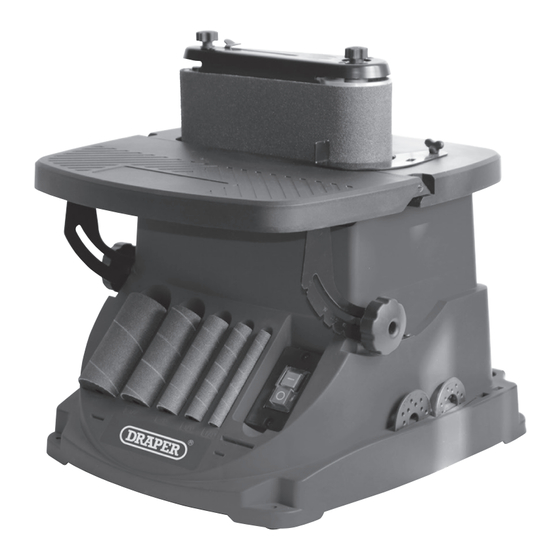
Table of Contents
Advertisement
Quick Links
230V OSCILLATING
SPINDLE AND BELT
SANDER
98425
These instructions accompanying the product are the original instructions. This document is part of the product, keep
it for the life of the product passing it on to any subsequent holder of the product. Read all these instructions before
assembling, operating or maintaining this product.
This manual has been compiled by Draper Tools describing the purpose for which the product has been designed,
and contains all the necessary information to ensure its correct and safe use. By following all the general safety
instructions contained in this manual, it will ensure both product and operator safety, together with longer life of the
product itself.
All photographs and drawings in this manual are supplied by Draper Tools to help illustrate the operation of the
product.
Whilst every effort has been made to ensure the accuracy of information contained in this manual, the Draper Tools
policy of continuous improvement determines the right to make modifications without prior warning.
Advertisement
Table of Contents
Troubleshooting

Summarization of Contents
Warranty Information
Warranty Terms and Conditions
Covers the tool's warranty period, terms, conditions, and limitations for repairs and defects.
Introduction to the Sander
Scope of Use
Describes the intended use and purpose of the oscillating spindle and belt sander.
Technical Specifications
Details the technical specifications of the sander, including voltage, power, dimensions, and weight.
Handling and Storage Guidelines
Provides essential guidelines for safely handling and storing the sander to prevent damage and ensure longevity.
Health and Safety Information
General Power Tool Safety
General safety warnings and precautions applicable to all power tools, covering work area, electrical, and personal safety.
Sander-Specific Safety
Specific safety instructions and warnings tailored for the operation of this particular sander model.
Additional Sander Safety Tips
Further safety recommendations for sander use, focusing on workpiece security, personal protective equipment, and operational conduct.
Residual Risk Awareness
Highlights inherent residual risks associated with power tool operation that cannot be fully eliminated.
Power Supply Connection
Instructions for safe electrical connection, including plug, fuse replacement, and extension lead usage.
Technical Description and Identification
Part Identification
Illustrates and labels all the parts and components of the sander for easy identification.
Unpacking and Checking Contents
Packaging Inspection
Guidance on safely unpacking the sander and inspecting it for any transit damage.
Included Accessories
Lists all the accessories and parts included with the sander for verification.
Preparing the Sander for Use
Tool Holder Usage
Details the sander's tool holders for storing sanding sleeves and rubber drums.
Bobbin and Drum Storage
Instructions on placing sanding sleeves and rubber drums onto storage pins.
Insert Storage
Guidance on storing table inserts in their designated slots.
No-Volt ON/OFF Switch Operation
Explanation of the no-volt type ON/OFF switch and its function during power interruptions.
Bench Mounting Procedure
Instructions for securely mounting the sander to a workbench for stability and safe operation.
Operating the Sander
Dust Extraction Setup
Importance and method of connecting dust extraction for health and safety during operation.
Converting to Belt Sander Mode
Detailed steps to convert the sander into belt sander mode, including part removal and installation.
Belt Tracking Adjustment
Procedure for adjusting the belt tracking using the dedicated knob to ensure correct belt alignment.
Converting to Spindle Sander Mode
Instructions for converting the sander to spindle sander mode, including part fitting and tightening.
Table Tilting Functionality
Guide to tilting the table for various edge work, detailing angle settings and lockable notches.
Maintenance and Troubleshooting
Routine Maintenance
General guidelines for regular inspection and cleaning to keep the tool in optimal working condition.
Cleaning Procedures
Specific instructions on how to clean the sander, including recommended cleaning agents and areas to focus on.
Carbon Brush Replacement
Step-by-step instructions for replacing worn carbon motor brushes to restore power and performance.
Troubleshooting Guide
A guide to common problems, their potential causes, and recommended solutions for the sander.
Explanation of Symbols
Symbol Definitions
Defines and explains the meaning of various symbols and icons used throughout the manual for safety and operation.
Product Disposal
End-of-Life Disposal
Provides guidance on the environmentally responsible disposal of the sander at the end of its service life.














Need help?
Do you have a question about the 98425 and is the answer not in the manual?
Questions and answers